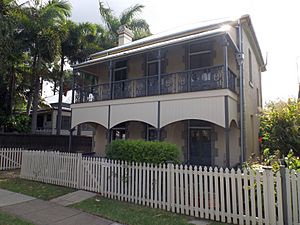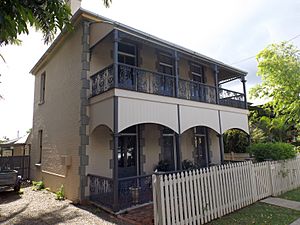La Trobe, East Brisbane facts for kids
Quick facts for kids La Trobe residence, East Brisbane |
|
|---|---|

Building in 2015
|
|
| Location | 58 LaTrobe Street, East Brisbane, Queensland, Australia |
| Design period | 1870s - 1890s (late 19th century) |
| Built | c. 1886 |
| Built for | William Henry Genn |
| Official name: La Trobe | |
| Type | state heritage (built) |
| Designated | 21 October 1992 |
| Reference no. | 600188 |
| Significant period | 1880s (fabric, historical) |
| Significant components | residential accommodation - main house, trees/plantings |
| Lua error in Module:Location_map at line 420: attempt to index field 'wikibase' (a nil value). | |
La Trobe is a special old house in East Brisbane, Queensland, Australia. It was built around 1886. This two-storey house is considered important because of its history and unique style. It was added to the Queensland Heritage Register on 21 October 1992, which means it's protected for future generations.
Contents
The Story of La Trobe House
This two-storey house was built around 1886. Its first owner was William Henry Genn. He was a plumber, an iron worker, and a wood carver.
How La Trobe Street Began
La Trobe Street was created in the mid-1880s. This happened when the land known as the Mowbraytown Estate was divided up. This area is where much of East Brisbane's history comes from.
The Mowbraytown Estate was once a large piece of land. It belonged to Rev. Thomas Mowbray. He was very important in starting the Presbyterian Church in Queensland. After he passed away in 1867, his wife sold part of the estate in 1884.
Building Homes in Mowbraytown
The new owner, Josiah Young, divided the land into many smaller blocks. These blocks were long and narrow. They were usually between 13 and 14 square perches in size. This was before a law in 1885 that made residential blocks larger.
Many working-class and lower-middle-class families bought these blocks. By 1887, there were 13 houses on La Trobe Street. Most of these homes belonged to skilled workers.
Unique Bricks of La Trobe
La Trobe house was built using bricks from William Williams' brickyard. This was unusual for Brisbane at the time. Most houses were made of timber because it was cheaper. You can tell Williams' bricks by a special mark. They have the imprint of an open hand with a heart.
La Trobe's Changing Life
The house likely got its name from its location on La Trobe Street. It was known as "La Trobe" by 1922. For many years, it was mostly rented out. It changed owners many times.
In the late 1940s, the house was changed into three separate flats. Later, some verandahs were enclosed. This means they were built in to become part of the house.
New owners started fixing up the house in the early 1980s. They opened up the verandahs again. They added new cast-iron railings. A new kitchen was also built where the old one used to be.
What La Trobe House Looks Like
This two-storey brick house has a timber verandah at the front. The verandah has pretty cast-iron railings. The lower part has a timber valance, which is a decorative border. The upper part has a cast-iron fringe.
The brick walls have special decorative corners called quoins. The door and window frames also have detailed brickwork. Five pairs of French doors open onto the verandah. The front door also has a fanlight above it. A fanlight is a window shaped like a fan.
Inside, the walls are covered with wooden boards. Both floors have a central hallway. On the left side, there is one long room. This room has a fireplace with a cast-iron grate. On the right side, there are two rooms and the staircase.
The back verandah on the ground floor is enclosed. It has a curved iron roof. This area leads to the modern kitchen, a family room, a laundry, and a storeroom.
Tall street trees stand near the house. They add to the beauty of this special home.
Why La Trobe House is Important
La Trobe was added to the Queensland Heritage Register in 1992. This means it is recognized as a very important historical place.
Showing Queensland's History
The house helps us understand how Queensland's history unfolded. It shows how East Brisbane grew quickly in the 1880s. This growth happened especially after the Mowbraytown Estate was divided in 1884. La Trobe house adds a lot to the historical feel of East Brisbane. It also makes La Trobe Street look special.
A Unique Example
La Trobe house was built around 1886. It is a great example of a small, two-storey brick house from the 1880s. Houses made of brick like this were not very common in Brisbane at that time. This makes La Trobe quite unique.


